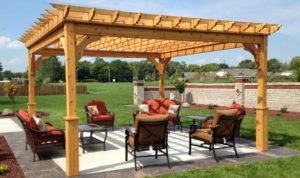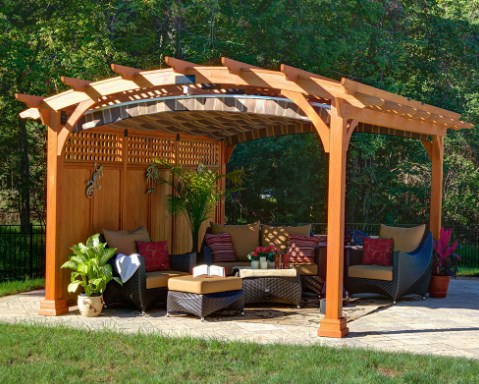 Pergola is translated from Italian as a canopy or extension. Initially, such a building was invented to support grape vines in sunny Italy.
Pergola is translated from Italian as a canopy or extension. Initially, such a building was invented to support grape vines in sunny Italy.
Later, people realized the convenience of this design and began to use it for other climbing plants. Currently, pergola is especially popular in landscape design.
It is an architectural structure made of pillars, columns and arches. A pergola does not have a roof; this is its main difference from a gazebo. Instead of a roof that protects from bad weather, the product has a canopy made of transverse and longitudinal beams. Such lattice blocks allow sunlight and rain to pass through. Most often, such buildings are entwined with various plants, which ultimately creates a beautiful garden composition.
This design has several purposes:
- Support for climbing plants.
- Protection from direct sunlight in hot weather.
- The green canopy will serve as an umbrella from direct sunlight, but the diffused light inside the pergola will be enough.
- Decoration of the garden plot.
- Outdoor seating area
Here you can sit comfortably in a comfortable chair with a book or arrange gatherings with guests over cups of tea.
Kinds
The product comes in several types. It will be built either as a separate building on your site or as an extension to another building, for example, to a terrace.
Pergola in landscape design
 It occupies a good position in landscape design. With the help of this structure, you can shift the emphasis in the garden in the right direction. You can cover any object with it.
It occupies a good position in landscape design. With the help of this structure, you can shift the emphasis in the garden in the right direction. You can cover any object with it.
Or, on the contrary, to focus attention on it, for example, to fit a pergola into the composition of the entrance gate. You can design it in the form of a green corridor, on the sides there will be a hedge of honeysuckle, and the top in the shape of an arch is also entwined with climbing plants.
The product will help you in zoning your site. It will be easy to divide the garden plot into a children's play area, a recreation area, a barbecue area, or make an adjacent pergola to the house for parking a personal car in the form of a canopy.
Advantages and disadvantages
The advantages include the lightness of the design. Lightness is achieved not through the weight of the structure, but through the creation of weightlessness, as a result of the small use of building material. The main component of the pergola type is the green cover, which should cover the entire area of the building.
The disadvantages include the inability to protect you from bad weather. Living walls of plants will not protect from rain or wind.
She will also require your constant monitoring of her care. Whatever type of material you choose (we will consider them below), each of them will need control if you want the building to last a long time and at the same time look decent.
Nowadays, people are unlimited in their choice of materials for making buildings. This also applies to pergolas. You can make it from any material that you like and feel comfortable with.
 Wooden models are quite common in landscape stores. They look natural and natural in garden areas. Be sure to treat wooden pergolas against insects over the entire surface. They can settle in the structure of the tree, thereby spoiling the view and destroying the structure.
Wooden models are quite common in landscape stores. They look natural and natural in garden areas. Be sure to treat wooden pergolas against insects over the entire surface. They can settle in the structure of the tree, thereby spoiling the view and destroying the structure.
It is also recommended to coat such a building with varnish, which will protect the surface from moisture. The wooden model can be purchased unassembled and assembled yourself. Or, initially, come up with a design yourself and make your own product that will suit your garden interior style.
Forged pergolas look good and impressive in the owners’ garden displays. But it will be impossible to make such a product yourself, without special forging skills.
Metal pergolas are difficult to make and look light and elegant. One more problem - this is a lot of weight, which must have a reliable foundation. It should be protected from corrosion by covering it with a special agent.
Pergolas made of stones or bricks look very massive and bulky. It is better to place such buildings on large garden plots, where it will not attract all the attention.
Plastic pergolas are very inexpensive, but also have the shortest service life. In winter they may crack from frost or from a lot of snow. In summer they may fade (this can be corrected with paint).
There is also the option of combined products that are made from several materials at once. The most common combinations are wood and stone or wood and metal.
Attention! Regardless of the choice of material, remember that your pergola must support the heavy weight of living plants. It must be strong and stable.
There are a lot of models, but the main ones are:
- the classic straight version is a hollow box with 90-degree angles or with arches in the form of a ceiling.
- fan option. When the visor diverges from one point in different directions in the form of a fan.
- rounded, have walls with horizontal or vertical convexities.
- a broken pergola has several breaks in its structure.
Important! The product must be resistant to gusts of wind. Pay careful attention to strengthening the building.
Which pergola is better to choose
 The choice of product for your garden plot depends only on your personal vision of this building on the site.
The choice of product for your garden plot depends only on your personal vision of this building on the site.
Here it is worth taking into account the style of construction and its size, its appearance and character. Define the purpose of the pergola. Select your desired material. Assess your financial capabilities. All these criteria should lead you to choosing the ideal pergola for your garden.


 1
1





